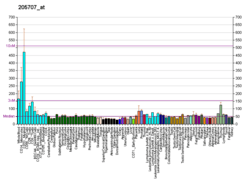IL17RA
Interleukin 17 receptor A, also known as IL17RA and CDw217 (cluster of differentiation w217), is a human gene.[5]
Interleukin 17A (IL17A)is a proinflammatory cytokine secreted by activated T-lymphocytes. It is a potent inducer of the maturation of CD34-positive hematopoietic precursors into neutrophils. The protein encoded by this gene (interleukin 17A receptor; IL17RA) is a ubiquitous type I membrane glycoprotein that binds with low affinity to interleukin 17A. Interleukin 17A and its receptor play a pathogenic role in many inflammatory and autoimmune diseases such as rheumatoid arthritis. Like other cytokine receptors, this receptor likely has a multimeric structure.[5]
See also
References
Further reading
- Yao Z, Spriggs MK, Derry JM, et al. (1998). "Molecular characterization of the human interleukin (IL)-17 receptor". Cytokine. 9 (11): 794–800. doi:10.1006/cyto.1997.0240. PMID 9367539.
- Dunham I, Shimizu N, Roe BA, et al. (1999). "The DNA sequence of human chromosome 22". Nature. 402 (6761): 489–95. doi:10.1038/990031. PMID 10591208.
- Honorati MC, Meliconi R, Pulsatelli L, et al. (2001). "High in vivo expression of interleukin-17 receptor in synovial endothelial cells and chondrocytes from arthritis patients". Rheumatology (Oxford). 40 (5): 522–7. doi:10.1093/rheumatology/40.5.522. PMID 11371660.
- Footz TK, Brinkman-Mills P, Banting GS, et al. (2001). "Analysis of the Cat Eye Syndrome Critical Region in Humans and the Region of Conserved Synteny in Mice: A Search for Candidate Genes at or near the Human Chromosome 22 Pericentromere". Genome Res. 11 (6): 1053–70. doi:10.1101/gr.154901. PMC 311098. PMID 11381032.
- Haudenschild D, Moseley T, Rose L, Reddi AH (2002). "Soluble and transmembrane isoforms of novel interleukin-17 receptor-like protein by RNA splicing and expression in prostate cancer". J. Biol. Chem. 277 (6): 4309–16. doi:10.1074/jbc.M109372200. PMID 11706037.
- Kehlen A, Thiele K, Riemann D, Langner J (2002). "Expression, modulation and signalling of IL-17 receptor in fibroblast-like synoviocytes of patients with rheumatoid arthritis". Clin. Exp. Immunol. 127 (3): 539–46. doi:10.1046/j.1365-2249.2002.01782.x. PMC 1906300. PMID 11966773.
- Strausberg RL, Feingold EA, Grouse LH, et al. (2003). "Generation and initial analysis of more than 15,000 full-length human and mouse cDNA sequences". Proc. Natl. Acad. Sci. U.S.A. 99 (26): 16899–903. doi:10.1073/pnas.242603899. PMC 139241. PMID 12477932.
- Steiner GE, Newman ME, Paikl D, et al. (2003). "Expression and function of pro-inflammatory interleukin IL-17 and IL-17 receptor in normal, benign hyperplastic, and malignant prostate". Prostate. 56 (3): 171–82. doi:10.1002/pros.10238. PMID 12772186.
- Zhang Z, Henzel WJ (2005). "Signal peptide prediction based on analysis of experimentally verified cleavage sites". Protein Sci. 13 (10): 2819–24. doi:10.1110/ps.04682504. PMC 2286551. PMID 15340161.
- Gerhard DS, Wagner L, Feingold EA, et al. (2004). "The Status, Quality, and Expansion of the NIH Full-Length cDNA Project: The Mammalian Gene Collection (MGC)". Genome Res. 14 (10B): 2121–7. doi:10.1101/gr.2596504. PMC 528928. PMID 15489334.
- McAllister F, Henry A, Kreindler JL, et al. (2005). "Role of IL-17A, IL-17F, and the IL-17 Receptor in Regulating Growth-Related Oncogene-α and Granulocyte Colony-Stimulating Factor in Bronchial Epithelium: Implications for Airway Inflammation in Cystic Fibrosis". J. Immunol. 175 (1): 404–12. doi:10.4049/jimmunol.175.1.404. PMC 2849297. PMID 15972674.
- Pongcharoen S, Niumsup P, Sanguansermsri D, et al. (2006). "The effect of interleukin-17 on the proliferation and invasion of JEG-3 human choriocarcinoma cells". Am. J. Reprod. Immunol. 55 (4): 291–300. doi:10.1111/j.1600-0897.2006.00366.x. PMID 16533341.
- Toy D, Kugler D, Wolfson M, et al. (2006). "Cutting edge: interleukin 17 signals through a heteromeric receptor complex". J. Immunol. 177 (1): 36–9. doi:10.4049/jimmunol.177.1.36. PMID 16785495.
- Wang X, Dong Z, Zhu DD, Guan B (2006). "Expression profile of immune-associated genes in nasal polyps". Ann. Otol. Rhinol. Laryngol. 115 (6): 450–6. PMID 16805377.
- Rong Z, Cheng L, Ren Y, et al. (2007). "Interleukin-17F signaling requires ubiquitination of interleukin-17 receptor via TRAF6". Cell. Signal. 19 (7): 1514–20. doi:10.1016/j.cellsig.2007.01.025. PMID 17346928.
- Maitra A, Shen F, Hanel W, et al. (2007). "Distinct functional motifs within the IL-17 receptor regulate signal transduction and target gene expression". Proc. Natl. Acad. Sci. U.S.A. 104 (18): 7506–11. doi:10.1073/pnas.0611589104. PMC 1863505. PMID 17456598.
External links
- IL17RA+protein,+human at the US National Library of Medicine Medical Subject Headings (MeSH)
This article incorporates text from the United States National Library of Medicine, which is in the public domain.




